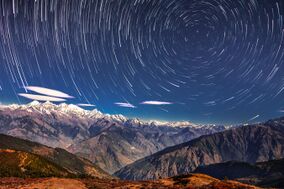Biology:Langtang National Park
| Langtang National Park | |
|---|---|
| Nepali: लाङटाङ राष्ट्रिय निकुञ्ज | |
IUCN category II (national park) | |
 Langtang National Park | |
| Location | Nepal |
| Nearest city | Kathmandu |
| Coordinates | [ ⚑ ] : 28°10′26″N 85°33′11″E / 28.1738°N 85.5531°E |
| Area | 1,710 km2 (660 sq mi) |
| Established | 1976 |
| Governing body | Department of National Parks and Wildlife Conservation |
Langtang National Park is a national protected area in north-central Nepal. It was established in 1976 as Nepal's first Himalaya n national park and the country's fourth protected area. It covers an area of 1,710 km2 (660 sq mi) in the Nuwakot, Rasuwa and Sindhulpalchok Districts of the central Himalayan region. It contains 26 village communities and includes the Langtang valley. In the north and east it is linked with Qomolangma National Nature Preserve in the Tibet Autonomous Region.[1] The eastern and western boundaries follow the Bhote Koshi and the Trishuli river, respectively.[2]
The Gosainkunda lake is located at an elevation of 4,300 m (14,100 ft) inside the park. The Dorje Lakpa range at 6,988 m (22,927 ft) bisects the park from west–east to south–east. The summit of Langtang Lirung (7,245 m (23,770 ft)) is the highest point in the park.[3]
Langtang National Park is part of the Sacred Himalayan Landscape.[4] On 31 July 1992 Thai Airways International Flight 311 crashed on Langtang National Park. Killing all 113 people on board.
History
In 1970, royal approval designated the establishment of Langtang National Park as the first protected area in the Himalayas. The national park was gazetted in 1976 and extended by a buffer zone of 420 km2 (160 sq mi) in 1998.[1][5]
On 31 July 1992, Thai Airways International Flight 311 crashed into the park. The Airbus A310 was on approach to Tribhuvan International Airport in Kathmandu. All 113 people on board were killed.[6]
In April 2015, the village of Langtang, located within the park, was destroyed by an avalanche of ice, rock and mud triggered by the April 2015 Nepal earthquake. At least 215 people were killed. In 2016, the International Astronomical Union named a 9.8km wide crater on Mars after the village, as a tribute. [7] The destruction of the village and other events taking place in Nepal before, during, and after the earthquake are documented in the 2022 Netflix mini-series Aftershock: Everest and the Nepal Earthquake.[citation needed]
Climate
The climate of the park is dominated by the southwest summer monsoon; most of the annual precipitation occurs from June to September, and temperatures vary greatly due to the extreme difference in elevation.[8]
Flora and fauna
Langtang National Park exhibits a high diversity of 14 vegetation types in 18 ecosystem types, ranging from upper tropical forests below 1,000 m (3,300 ft) m altitude to alpine scrub and perennial ice.[1]
References
- ↑ 1.0 1.1 1.2 Bhuju, U. R.; Shakya, P. R.; Basnet, T. B.; Shrestha, S. (2007). Nepal Biodiversity Resource Book. Protected Areas, Ramsar Sites, and World Heritage Sites. Kathmandu: International Centre for Integrated Mountain Development, Ministry of Environment, Science and Technology, in cooperation with United Nations Environment Programme, Regional Office for Asia and the Pacific. ISBN 978-92-9115-033-5. http://lib.icimod.org/record/7560.
- ↑ Yonzon, P.; Jones, R.; Fox, J. (1991). "Geographic Information Systems for Assessing Habitat and Estimating Population of Red Pandas in Langtang National Park, Nepal". Ambio 20 (7): 285–288.
- ↑ Mishra, P. N. (2003). "The Langtang National Park: a proposed first Biosphere Reserve in Nepal". Journal of the National Science Foundation of Sri Lanka 31 (1&2): 333–335. https://jnsfsl.sljol.info/articles/10.4038/jnsfsr.v31i1-2.3045/galley/2437/download/.
- ↑ Gurung, C. P.; Maskey, T. M.; Poudel, N.; Lama, Y.; Wagley, M. P.; Manandhar, A.; Khaling, S.; Thapa, G. et al. (2006). "The Sacred Himalayan Landscape: Conceptualizing, Visioning, and Planning for Conservation of Biodiversity, Culture and Livelihoods in the Eastern Himalaya". Conservation Biology in Asia. Kathmandu: Nepal Society for Conservation Biology, Asia Section and Resources Himalaya Foundation. pp. 10–20. ISBN 99946-996-9-5. https://conbio.org/images/content_groups/Asia/Chapter%201_Gurung_Himalayan%20Landscape.pdf.
- ↑ Heinen, J. T. and J. N. Mehta (2000). Emerging Issues in Legal and Procedural Aspects of Buffer Zone Management with Case Studies from Nepal. Journal of Environment and Development 9 (1): 45–67.
- ↑ Ranter, Harro. "ASN Aircraft accident Airbus A310-304 HS-TID Kathmandu-Tribhuvan Airport (KTM)". https://aviation-safety.net/database/record.php?id=19920731-0.
- ↑ Cheung, Helier. "Mars crater named after Nepal quake village Langtang". https://www.bbc.com/news/world-asia-36560136.
- ↑ Sayers, K.; Norconk, M.A. (2008). "Himalayan Semnopithecus entellus at Langtang National Park, Nepal: Diet, activity patterns, and resources". International Journal of Primatology 29: 509–530. http://www.personal.kent.edu/~mnorconk/Sayers_Ken.pdf.
External links
| Wikivoyage has a travel guide for Langtang National Park. |
| Wikivoyage has a travel guide for Langtang Valley Trek. |
- BirdLife International. "Important Bird Areas factsheet: Langtang National Park". http://datazone.birdlife.org/site/factsheet/14334.
- "Langtang National Park". http://www.dnpwc.gov.np/protected_areas/details/langtangnationalpark.
- EnvironmentNEPAL Langtang National Park
pl:Park Narodowy Langtang
 |




